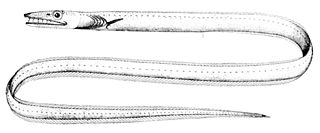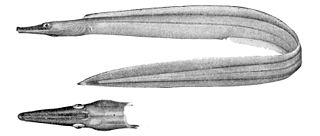Nessorhamphus is a genus of eels in the family Derichthyidae. It currently contains the following species:
The Dana duckbill eel is an eel in the family Derichthyidae. It was described by Johannes Schmidt in 1931. It is a marine, deep water-dwelling eel which is known from throughout the Atlantic, Pacific, and Indian Ocean, including Australia, Brazil, Benin, Bangladesh, Cameroon, Cambodia, China, Ghana, Pakistan, Côte d'Ivoire, Guinea, India, Mozambique, Guinea-Bissau, Indonesia, Liberia, Malaysia, Kenya, Mauritania, Myanmar, Nigeria, Papua New Guinea, Senegal, Sierra Leone, the Philippines, Somalia, South Africa, Tanzania, Sri Lanka, Thailand, Togo, the Hawaiian Islands, USA; Yemen, and Vietnam. Males can reach a maximum total length of 30 centimetres.
The dogface witch eel is an eel in the family Nettastomatidae. It was described by Charles Henry Gilbert in 1891. It is a marine, deep water-dwelling eel which is known from the eastern central Pacific Ocean, including Point Conception, California, USA; Panama, Guadalupe, and the Galapagos Islands. The fish is known to dwell at an approximate depth of 734 meters. Males can reach a maximum total length of 90 centimetres.
The Facciola's sorcerer, also known as the Facciola sorcerer in Uruguay is an eel in the family Nettastomatidae. It was described by Cristoforo Bellotti in 1883. It is a marine, subtropical eel which is known from the eastern Atlantic Ocean, including southern Portugal, Angola, and the Ligurian and Tyrrhenian seas. It dwells at a depth range of 30–731 metres; the young are known to inhabit caves, in which the larger specimens are found deeper. Males can reach a maximum standard length of 64.9 centimetres.

The blacktail pike-conger is an eel in the family Nettastomatidae. It was described by George Brown Goode and Tarleton Hoffman Bean in 1896. It is a subtropical, marine eel which is known from the western Atlantic Ocean. It is known to dwell at a maximum depth of 203 meters. Males can reach a maximum total length of 36.6 centimeters.
Hoplunnis megista is an eel in the family Nettastomatidae. It was described by David G. Smith and Robert H. Kanazawa in 1989. It is a marine, deep water-dwelling eel which is known from the western central Atlantic Ocean, including Nicaragua and Panama. It is known to dwell at a depth range of 366 to 421 meters. Males can reach a maximum total length of 91.7 centimeters (36.1 in).
The slender duckbill eel is an eel in the family Nettastomatidae. It was described by Charles Tate Regan in 1915. It is a marine, deep water-dwelling eel which is known from the Gulf of Guinea, in the eastern Atlantic Ocean. It inhabits the continental shelf and slope. Males can reach a maximum total length of 55.5 centimetres (21.9 in).
Hoplunnis schmidti is an eel in the family Nettastomatidae. It was described by Johann Jakob Kaup in 1860. It is a marine, tropical eel which is known from Venezuela, in the western central Atlantic Ocean.
Hoplunnis similis is an eel in the family Nettastomatidae. It was described by David G. Smith in 1989. It is a marine, deep water-dwelling eel which is known from the western central Atlantic Ocean, including Florida, USA, Honduras and Nicaragua. It is known to dwell at a depth range of 146 to 329 meters. Males can reach a maximum total length of 49.3 centimeters (19.4 in).
The spotted pike-conger, also known as the conger eel in Cuba, is an eel in the family Nettastomatidae. It was described by Isaac Ginsburg in 1951. It is a marine, deep water-dwelling eel which is known from the western Atlantic Ocean, including the Gulf of Mexico and the Straits of Florida, USA. It dwells at a depth range of 130 to 420 meters, and inhabits benthic sediments of mud. Males can reach a maximum total length of 46 centimeters (18 in).

The duck-billed eel also known as the shortsnouted sorcerer or the smallhead duckbill eel, is an eel in the family Nettastomatidae. It was described by Albert Günther in 1877. It is a marine, deep water-dwelling eel which is known from the Indo-Pacific and the southeastern Pacific Ocean, including Japan, Hawaii, eastern Australia, southeastern Africa, and Chile. It dwells at a depth range of 60–1190 metres, and inhabits the continental shelf and slope. Males can reach a maximum total length of 82 centimetres.
Nettenchelys exoria is an eel in the family Nettastomatidae. It was described by James Erwin Böhlke and David G. Smith in 1981. It is a marine, deep water-dwelling eel which is known from the western central Atlantic Ocean, including Florida, USA and the Bahamas. It dwells at a depth range of 277 to 494 meters. Males can reach a maximum total length of 46.7 centimeters (18.4 in).
Nettenchelys paxtoni is an eel in the family Nettastomatidae. It was described by Emma Stanislavovna Karmovskaya in 1999. It is a marine, tropical eel which is known from Vanuatu, in the western Pacific Ocean. Males can reach a maximum total length of 24.8 centimetres (9.8 in).
The pygmy pikeconger is an eel in the family Nettastomatidae. It was described by David G. Smith and James Erwin Böhlke in 1981. It is a marine, tropical eel which is known from the western central Atlantic Ocean, including Venezuela and the Gulf of Mexico, and possibly more locations. It is known to dwell at a depth range of 128 to 280 meters. Males can reach a maximum total length of 20.1 centimeters (7.9 in).
The slender sorcerer is an eel in the family Nettastomatidae. It was described by Wilhelm Peters in 1864. It is a marine, tropical eel which is known from the eastern Atlantic and Indian Ocean, including the River Congo and the Mediterranean. It dwells at a depth range of 185 to 700 metres. Males can reach a maximum total length of 65 centimetres (26 in).
The longface eel is an eel in the family Nettastomatidae. It was described by David G. Smith in 1989. It is a marine, tropical eel which is known from the western central Atlantic Ocean, including North Carolina and Florida, USA, the northwestern Gulf of Mexico, and Mobile Bay. It dwells at a depth range of 59 to 158 meters. Males can reach a maximum total length of 36 centimeters (14 in).
The blacktail buckbill eel, also known commonly as the blacktail duckbill, or the duckbill eel in Malaysia, is an eel in the family Nettastomatidae. It was described by David Starr Jordan and John Otterbein Snyder in 1901, originally under the genus Chlopsis. It is a marine, tropical eel which is known from the western Pacific Ocean, including Japan, China, Malaysia, the Philippines, and Taiwan. It is known to dwell at a depth range of 100 to 500 meters. Males can reach a maximum total length of 50 centimeters (20 in).
The pillar wire eel is an eel in the family Nettastomatidae. It was described by Einar Hagbart Martin Lea in 1913, originally under the genus Leptocephalus. It is a marine, tropical eel which is known from the western Pacific Ocean. It is oceanodromous, and is known to dwell at a depth range of 27 to 460 metres.

Venefica procera is an eel in the family Nettastomatidae. It was described by George Brown Goode and Tarleton Hoffman Bean in 1883, originally under the genus Nettastoma. It is a marine, deep water-dwelling eel which is known from the western central Atlantic Ocean, including North Carolina, USA, Suriname, the Gulf of Mexico and the Caribbean Sea. It dwells at a depth range of 326 to 2,304 meters. Males can reach a maximum total length of 109 centimeters (43 in).
The short-tooth sawpalate is an eel in the family Serrivomeridae. It was described by Johannes Schmidt in 1916, originally under the genus Leptocephalus. It is a marine, deep water-dwelling eel which is known from the eastern central and western central Atlantic Ocean, including the Bahamas and Bermuda, as well as the Strait of Gibraltar, Cape Verde, Canada and the United States. It dwells at a depth range of 150 to 1,000 metres. Males can reach a maximum total length of 65 centimetres (26 in).



